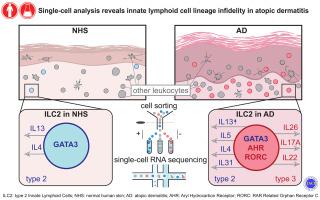Journal of Allergy and Clinical Immunology ( IF 14.2 ) Pub Date : 2021-08-05 , DOI: 10.1016/j.jaci.2021.07.025 Natalia Alkon 1 , Wolfgang M Bauer 1 , Thomas Krausgruber 2 , Issac Goh 3 , Johannes Griss 1 , Vy Nguyen 1 , Baerbel Reininger 1 , Christine Bangert 1 , Clement Staud 4 , Patrick M Brunner 1 , Christoph Bock 5 , Muzlifah Haniffa 6 , Georg Stingl 1

|
Background
Although ample knowledge exists about phenotype and function of cutaneous T lymphocytes, much less is known about the lymphocytic components of the skin’s innate immune system.
Objective
To better understand the biologic role of cutaneous innate lymphoid cells (ILCs), we investigated their phenotypic and molecular features under physiologic (normal human skin [NHS]) and pathologic (lesional skin of patients with atopic dermatitis [AD]) conditions.
Methods
Skin punch biopsies and reduction sheets as well as blood specimens were obtained from either patients with AD or healthy individuals. Cell and/or tissue samples were analyzed by flow cytometry, immunohistochemistry, and single-cell RNA sequencing or subjected to in vitro/ex vivo culture.
Results
Notwithstanding substantial quantitative differences between NHS and AD skin, we found that the vast majority of cutaneous ILCs belong to the CRTH2+ subset and reside in the upper skin layers. Single-cell RNA sequencing of cutaneous ILC-enriched cell samples confirmed the predominance of biologically heterogeneous group 2 ILCs and, for the first time, demonstrated considerable ILC lineage infidelity (coexpression of genes typical of either type 2 [GATA3 and IL13] or type 3/17 [RORC, IL22, and IL26] immunity within individual cells) in lesional AD skin, and to a much lesser extent, in NHS. Similar events were demonstrated in ILCs from skin explant cultures and in vitro expanded ILCs from the peripheral blood.
Conclusion
These findings support the concept that instead of being a stable entity with well-defined components, the skin immune system consists of a network of highly flexible cellular players that are capable of adjusting their function to the needs and challenges of the environment.
中文翻译:

单细胞分析揭示了特应性皮炎的先天淋巴细胞谱系不忠
背景
尽管关于皮肤 T 淋巴细胞的表型和功能存在大量知识,但对皮肤先天免疫系统的淋巴细胞成分知之甚少。
客观的
为了更好地了解皮肤先天淋巴细胞 (ILC) 的生物学作用,我们研究了它们在生理(正常人皮肤 [NHS])和病理(特应性皮炎 [AD] 患者的损伤皮肤)条件下的表型和分子特征。
方法
从患有 AD 的患者或健康个体获得皮肤穿孔活检和缩小片以及血液样本。通过流式细胞术、免疫组织化学和单细胞 RNA 测序分析细胞和/或组织样品,或进行体外/离体培养。
结果
尽管 NHS 和 AD 皮肤之间存在显着的数量差异,但我们发现绝大多数皮肤 ILC 属于 CRTH2 +子集并位于皮肤上层。皮肤 ILC 富集细胞样本的单细胞 RNA 测序证实了生物异质组 2 ILC 的优势,并且首次证明了相当大的 ILC 谱系不忠(2 型 [ GATA3和IL13 ] 或 3型典型基因的共表达/17 [ RORC、IL22和IL26 ] 单个细胞内的免疫)在损伤性 AD 皮肤中,在 NHS 中的程度要小得多。在来自皮肤外植体培养物和体外的 ILC 中证实了类似的事件从外周血中扩增 ILC。
结论
这些发现支持这样一个概念,即皮肤免疫系统不是一个具有明确定义的稳定实体,而是由一个高度灵活的细胞参与者网络组成,这些参与者能够根据环境的需求和挑战调整其功能。


























 京公网安备 11010802027423号
京公网安备 11010802027423号